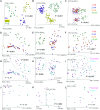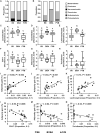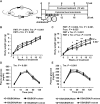Host Genetic Background and Gut Microbiota Contribute to Differential Metabolic Responses to Fructose Consumption in Mice
- PMID: 32856048
- PMCID: PMC7549307
- DOI: 10.1093/jn/nxaa239
Host Genetic Background and Gut Microbiota Contribute to Differential Metabolic Responses to Fructose Consumption in Mice
Abstract
Background: It is unclear how high fructose consumption induces disparate metabolic responses in genetically diverse mouse strains.
Objective: We aimed to investigate whether the gut microbiota contributes to differential metabolic responses to fructose.
Methods: Eight-week-old male C57BL/6J (B6), DBA/2J (DBA), and FVB/NJ (FVB) mice were given 8% fructose solution or regular water (control) for 12 wk. The gut microbiota composition in cecum and feces was analyzed using 16S ribosomal DNA sequencing, and permutational multivariate ANOVA (PERMANOVA) was used to compare community across mouse strains, treatments, and time points. Microbiota abundance was correlated with metabolic phenotypes and host gene expression in hypothalamus, liver, and adipose tissues using Biweight midcorrelation. To test the causal role of the gut microbiota in determining fructose response, we conducted fecal transplants from B6 to DBA mice and vice versa for 4 wk, as well as gavaged antibiotic-treated DBA mice with Akkermansia for 9 wk, accompanied with or without fructose treatment.
Results: Compared with B6 and FVB, DBA mice had significantly higher Firmicutes to Bacteroidetes ratio and lower baseline abundance of Akkermansia and S24-7 (P < 0.05), accompanied by metabolic dysregulation after fructose consumption. Fructose altered specific microbial taxa in individual mouse strains, such as a 7.27-fold increase in Akkermansia in B6 and 0.374-fold change in Rikenellaceae in DBA (false discovery rate <5%), which demonstrated strain-specific correlations with host metabolic and transcriptomic phenotypes. Fecal transplant experiments indicated that B6 microbes conferred resistance to fructose-induced weight gain in DBA mice (F = 43.1, P < 0.001), and Akkermansia colonization abrogated the fructose-induced weight gain (F = 17.8, P < 0.001) and glycemic dysfunctions (F = 11.8, P = 0.004) in DBA mice.
Conclusions: Our findings support that differential microbiota composition between mouse strains is partially responsible for host metabolic sensitivity to fructose, and that Akkermansia is a key bacterium that confers resistance to fructose-induced metabolic dysregulation.
Keywords: Akkermansia; fecal transplant; fructose; gene by diet interaction; gut microbiota; metabolic syndrome; microbiota-host interaction.
Copyright © The Author(s) on behalf of the American Society for Nutrition 2020.
Figures





References
-
- Koo HY, Wallig MA, Chung BH, Nara TY, Cho BHS, Nakamura MT. Dietary fructose induces a wide range of genes with distinct shift in carbohydrate and lipid metabolism in fed and fasted rat liver. Biochim Biophys Acta Mol Basis Dis. 2008;1782:341–8. - PubMed
